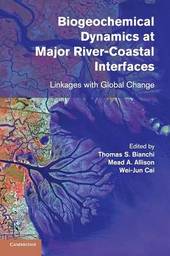
|
Biogeochemical Dynamics at Major River-Coastal Interfaces: Linkages with Global Change
Hardback
Main Details
| Title |
Biogeochemical Dynamics at Major River-Coastal Interfaces: Linkages with Global Change
|
| Authors and Contributors |
Edited by Thomas S. Bianchi
|
|
Edited by Mead A. Allison
|
|
Edited by Wei-Jun Cai
|
| Physical Properties |
| Format:Hardback | | Pages:674 | | Dimensions(mm): Height 254,Width 178 |
|
| ISBN/Barcode |
9781107022577
|
| Classifications | Dewey:551.9 |
|---|
| Audience | | Professional & Vocational | |
|---|
| Illustrations |
30 Tables, unspecified; 8 Plates, color; 250 Line drawings, unspecified
|
|
Publishing Details |
| Publisher |
Cambridge University Press
|
| Imprint |
Cambridge University Press
|
| Publication Date |
28 October 2013 |
| Publication Country |
United Kingdom
|
Description
This volume provides a state-of-the-art summary of biogeochemical dynamics at major river-coastal interfaces for advanced students and researchers. River systems play an important role (via the carbon cycle) in the natural self-regulation of Earth's surface conditions by serving as a major sink for anthropogenic CO2. Approximately 90 percent of global carbon burial occurs in ocean margins, with the majority of this thought to be buried in large delta-front estuaries (LDEs). This book provides information on how humans have altered carbon cycling, sediment dynamics, CO2 budgets, wetland dynamics, and nutrients and trace element cycling at the land-margin interface. Many of the globally important LDEs are discussed across a range of latitudes, elevation and climate in the drainage basin, coastal oceanographic setting, and nature and degree of human alteration. It is this breadth of examination that provides the reader with a comprehensive understanding of the overarching controls on major river biogeochemistry.
Author Biography
Thomas S. Bianchi is a Professor in the Department of Geological Sciences at the University of Florida, Gainesville, where he holds the Jon and Beverly Thompson Endowed Chair of Geological Sciences. His general areas of expertise are organic geochemistry, biogeochemical dynamics of aquatic food chains, carbon cycling in estuarine and coastal ecosystems, and biochemical markers of colloidal and particulate organic carbon. He has published more than 130 articles in refereed journals and four books, including Biogeochemistry of Gulf of Mexico Estuaries (1999, lead co-editor with Pennock and Twilley), Biogeochemistry of Estuaries (2007), Hypoxia in the Northern Gulf of Mexico (2010, co-author with Dale et al.) and Chemical Biomarkers in Aquatic Ecosystems (2011, lead co-author with Canuel). In 2012, he was elected as a Fellow of the American Association for the Advancement of Science. Mead A. Allison is the Director of Physical Processes and Sediment Systems at The Water Institute of the Gulf in Baton Rouge, Louisiana, and a Professor of Earth and Environmental Sciences at Tulane University, New Orleans, Louisiana. His general areas of expertise are sedimentology of the continental margin, particle-reactive radioisotopes, seafloor mapping, geomorphic impact of cyclonic storms, and the impact of human alteration of coastal environments. He has worked in riverine, coastal, estuarine and shelf systems around the world with particular emphasis on the continental margins of the Mississippi-Atchafalaya, Amazon and Ganges-Brahmaputra rivers. He has published more than eighty articles in refereed journals and is the primary author (with DeGaetano and Pasachoff) of the high-school level textbook Earth Sciences (2008). Wei-Jun Cai is a Professor in the School of Marine Science and Policy at the University of Delaware, Newark. Prior to this position, he was a Professor at the University of Georgia. He studies air-sea CO2 exchange, carbon cycling, and ocean acidification in coastal waters and marine sediments, and develops sensors for carbon cycle research. He has worked in coastal systems around the world including the US southeastern rivers and shelf, the Mississippi River plume and northern Gulf of Mexico shelf system, the South and East China Seas, and the Arctic Ocean. He has published more than eighty articles in refereed journals. Cai is currently Associate Editor of the journal Marine Chemistry. He has served on many national committees and is currently a member of the US Carbon Cycle Science Steering Group.
|